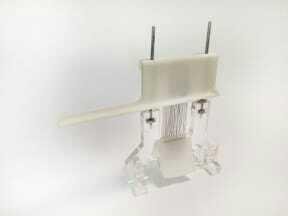Fog harp' makes water out of thin air
In some of the most arid regions of the world, from the Sahara to the Andes, special nets have long been used to catch moisture from the air, turning fog into drinking water.
These fog harvesters are put up against wind streams to catch microscopic droplets which gather and merge on a fine mesh until they have enough weight to travel down into a water tank. They provide essential access to water to many communities, and the technology behind them has evolved over the years to offer a higher yield, resistance to the elements and a reduced need for maintenance.
Now, researchers at Virginia Tech University have developed a new design that they say has three times the efficiency of regular fog nets. They call it a "harp," because its vertical pattern of wires makes it resemble the string instrument.
"Our long-term goal is that the fog harp can completely replace the classical net design, resulting in cheaper fog harvesters that end up collecting substantially more water," Jonathan Boreyko, one of the authors of the study at Virginia Tech, said in an email interview.

Improved design
The problem with the classical design, according to Boreyko, is that the fog droplets end up getting stuck in the holes of the net, because the horizontal wires obstruct their path on the way down into the reservoir. The net then becomes heavily clogged with water, which makes it impermeable to the wind. As a result, the foggy wind simply flows around the net, instead of through it, which reduces the amount of fog that can be collected.
The fog harp consists instead of an array of vertical wires held under tension within a frame, without any intersecting wires, so that droplets can easily slide down at very small sizes.
"This solves the clogging issue to ensure that the wind can continuously flow through the harp for efficient fog capture," said Boreyko.
Threefold increase
Boreyko and his team ran a series of tests comparing scale-model harps and traditional nets, with artificial fog emanating from an ultrasonic humidifier. The team published their findings in the journal ACS Applied Materials & Interfaces.
"Our best fog harp was able to capture three times the amount of water harvested by a classic net structure of equivalent dimensions, using the exact same fog conditions," said Boreyko.
"The fog harp never showed any appreciable clogging and was able to continuously drain droplets as small as one millionth of a liter into the bottom collector, while the equivalent net got heavily clogged with water, which disrupted the passage of the fog stream."

Josh Tulkoff from the Virginia Tech research team strings a fog harp prototype. Credit: Virgina Tech
Although the design has shown potential at the model scale, real-world testing is now required. The team has built a full-scale prototype by winding wire around threaded bolts within a 1-meter squared frame, and will test alongside an equivalent mesh netting at Kentland Farm, an area close to the Virginia Tech campus known for its foggy weather.
A worldwide issue
Fog nets have been used since the 1980s in many parts of the world, including Africa, South America, Asia, the Middle East, and California. The largest fog collection project in the world is in Morocco, where over 600 square meters of nets provide drinking water to hundreds in a region severely hit by droughts induced by climate change.
With water crises looming in many parts of the world, devising innovative and sustainable ways to gain access to clean water is essential.
Fog nets have been used since the 1980s in many parts of the world, including Africa, South America, Asia, the Middle East, and California. The largest fog collection project in the world is in Morocco, where over 600 square meters of nets provide drinking water to hundreds in a region severely hit by droughts induced by climate change.
With water crises looming in many parts of the world, devising innovative and sustainable ways to gain access to clean water is essential.

Fog collection in Chile
Its unique design could help the fog harp reach into new areas, and cut costs where current fog harvesters are in use. "A harp design only needs half as much wiring as a mesh netting," said Boreyko, "Therefore, if a cost-effective method for wiring a harp can be obtained, the material costs of a fog harp should be less than an equivalent net."
Reference:
https://edition.cnn.com/style/article/fog-harp-virginia-tech/index.html
Your post has been upvoted by the @steemainsarena community trail. Our goal is to support minnows on steemit to help them grow. You can join our discord server here; https://discord.gg/V5hJwJn
You can support us by donating steem/sbd or delegating sp to steemainsarena trail to acknowledge our mission.